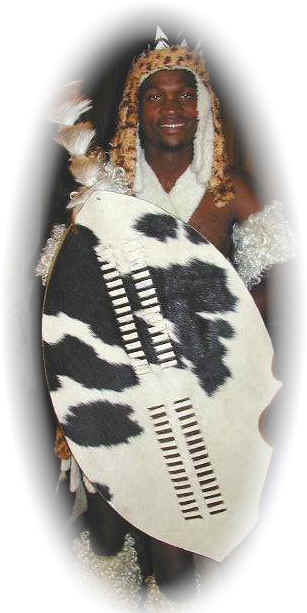![]()

![]()
"The shape of the gold shield is drum-like. It has a dual function: the display of identity and of spiritual defence."
www.gov.za/symbols/coatofarms.htm
The shield
The shield was an essential part of the weaponry of the Zulu Nation. In the days of their great King Shaka, every Zulu warrior was armed with a shield, one or more throwing assegais (type of spear) and a stabbing spear. Two classes of warriors existed: the married men, who carried a white/light shield and wore a headring and were called "whites" and the unmarried young men, with black/dark shields who were known as "blacks" and were the elite of the warriors. Shaka’s own shield was white with a black dot in the centre.
The Zulu shield, like flags and Coats of Arms, served as a symbol of national identity. It was considered a disgrace for a warrior to loose his shield to the enemy. If a Zulu General was killed in battle, his body was covered with shields as a mark of respect, much like the practice today, where coffins of dead soldiers who have died for their country, are draped with the national flag.
The Zulu
shield was considered an essential item in tribal life and signified defensive
rather than offensive use. Although
it was often not used in actual fighting, the spiritual attachment lent
to it ensured that it was returned from the battlefields to be kept in
a designated hut at the royal kraal (enclosure).
The fighting or war shield (isiHlangu) was at least 4’6” by 2’6” (1,215 by ,750 cm) and was designed to cover the whole height of the warrior. It was kept in the Royal Kraal and given out by the King before battle and whilst the impi (warriors) were being counselled by regimental commanders on warfare and bravery.
Not only did the shield give physical protection, but protection of a symbolic nature was implied as well. Shields were seen to have medicinal, magic powers. Before battle, shields were sprinkled with herbs (muti). This was done to increase the protective power of the shield, to ensure that the warrior came to no harm.
It was tradition for an attendant to hold a shield above the king’s head whenever he was residing at an indaba (meeting). This custom was more a sign of protection befitting of a Royal, rather than shading the king from the sun.
To build up the courage of the warriors, they were sent out into the open during violent thunderstorms with only their shields as protection against the lightning. If they survived unharmed, it was attributed to the magic, protective power of the shield.
Shields were made from the dried hides of well chosen, fat and healthy cattle. The hide was stretched with pegs until dry, then placed overnight under manure in the cattle kraal (enclosure), to soften it before cutting. Any uneven portions remaining the next day, were beaten with a stone until flattened. The shield was then cut out to the required design.
A slightly smaller shield was used for hunting. It was called iHubelo, and was thought to have powers to bring luck to a hunting party; to ensure the success of the hunt.
Decorative shields
of two by one feet (60 by 30 cm) were used at dances and a minute shield
was carried around during courting as a means of enhancing the appearance
of manliness and strength of the suitor.
The courting shield was called the Gqoka.